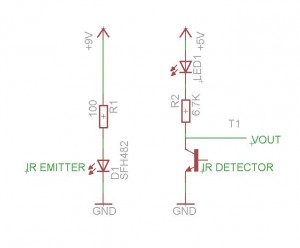Mouse Nose Poke! An IR Beam-Break circuit
Scientific research mice are often trained behaviorally by giving them treats as rewards.
Some Neuroscience students that I met recently train their mice by giving the treat when they poke their noses into an area of the enclosure they are running around in.

The area contains an IR emitter and receiver. When the mouse pokes its nose into the area, it breaks the beam and some kind of treat is delivered.
The idea is to take data on how desperate the mouse is to get the treat, whatever that may be. In some cases they are studying the effects of drugs, and in other cases, the effect of food.
The students had a small issue, their Nose Poke module plugs into a larger instrument, that collects data and does a bunch of other stuff. Unfortunately, since it’s part of the larger system, the Nose Poke module needs 28V to work.
All they need for many of their experiments is a Nose Poke that puts out an active high or low that runs on 5V. In fact, because of the difficulty in interfacing with the larger instrument, their rig to get to 5 Volts is complicated and is prone to mechanical error.
Today, I started building them a simple 5 Volt Nose Poke system that they can easily add into their existing data collection system.
I started at my favorite store, Radio Shack. Radio Shack is the only local place around here that sells components. They pretty much have most of the basics and for $3.79, I walked out with part number 276-0142, Infrared Emitter and Detector. With 2 resistors and a display LED to show that the circuit is working, I came up with this circuit:

When you put your finger in between the Emitter and Detector, the display LED (the red one) shuts off.
It was good to run a quick test on the circuit- I hadn’t specc’d IR components before and Digikey (my next stop after Radio Shack) provides many options. I wanted to get a sense of the important specifications to shop for. It is clear that the further away the emitter and detector are from each other, the more power is needed. By the way, the 100 ohm resistor that I used in the above circuit for the Emitter makes a nice bright beam but gets hot (and its a 1/2 Watt). Using more resistance didn’t allow the Emitter to provide enough power to get to the Detector.
Next steps: choose parts and design PCB.
Thanks to Rick Eh? for the mouse photo